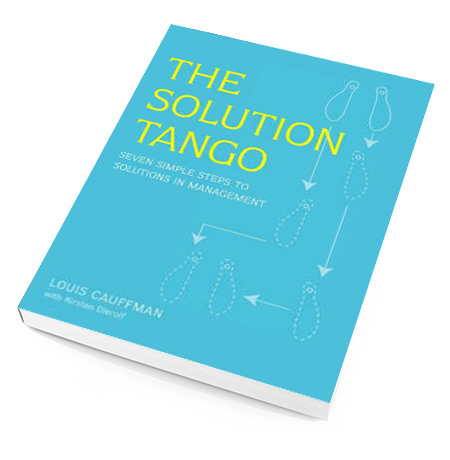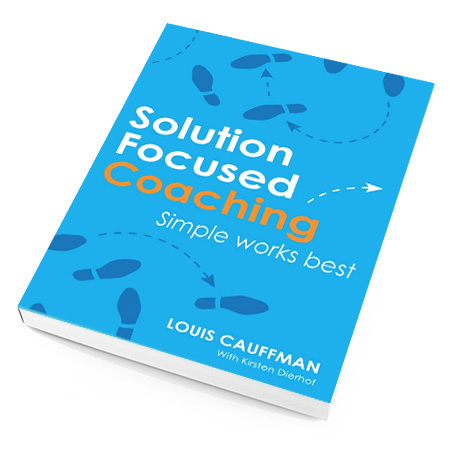Episode 5 – The Man in the Middle: A Solution Focused Feuilleton
The intervention
The CEO decided to ask Steve for help. Steve is vice president of the sales department. He is known for his tenacious diplomatic skills that provided him with the nickname “the gentle Pitbull.” Steve goes back a long time with Peter — so it will be no problem to get his help accepted by Peter. Jeff asks Steve to coach Peter and John in order to:
- Put Peter back on the right track.
- Get the dismantling project on track.
- Improve the cooperation between John and Peter.
- Make sure that their team keeps its sharp edge.
Steve sends the following email:
Highest priority Strictly confidential
From: Steve@solteam.com
To: Peter@solteam.com; John@solteam.com cc: Jeff@solteam.com
Re: dismantling project
Peter, John,
Jeff told me about the high-pressure situation surrounding the dismantling project. Jeff expressed his conviction that the two of you are the experts to handle this difficult project IF you cooperate. He asked me to help you steer away from counterproductivity. Jeff gave me the mandate to try and help you out. If this will not work, he will take it to the board.
I hope you both agree with this offer.
I will talk to you individually first and then I offer to coach Peter on the dismantling project.
I expect your go or no-go within 48 hours.
Strict confidentiality and discretion is vital. We will solve this problem before Solteam. suffers from it.
Hope to hear from you soon.
All emails on this topic must be copied to all parties concerned (no bcc’s please). I will do the same.
Best regards, Steve, VP Sales.
John was the first to react. He emailed Steve that it was OK for him. John sees the fact that “Peter needs a coach” as proof of the fact that he himself is “right.” He then sent Peter a short memo in which he again — but now with an undertone of sarcasm — wishes Peter “the best of luck.”
Peter took the full 48 hours to react. Then he called Steve’s secretary to make an appointment.
Steve emails everybody involved to confirm that they are in the game. He will first talk to Peter.
Meeting 1
Steve contacts Peter to make an appointment. Their first meeting is held in Peter’s office. Peter has, of course, prepared for this meeting very well. He is determined to explain the “truth” about how the company’s way of working has changed and especially about John. Peter rattles on about this for ten minutes.

Steve makes sure that Peter feels at ease by allowing him to let off steam. Steve simply listens because he knows from experience that arguing is counterproductive at this stage: people tend to cling even more tightly to their beliefs when they feel challenged. While Peter vents, Steve concentrates on little exceptions in Peter’s story about the quarrel. When he feels that Peter’s arguments are losing momentum, Steve seizes the opportunity to ask the goal-setting question that will help to point Peter’s nose in a more constructive direction.
Steve: “OK, Peter, you’ve made your point. What do you think we should discuss during this meeting so that it will be useful?” Goal setting question
Peter: “I don’t know. That is something the management has to decide. Or John, for all I care. I am doing my job and that should be enough. If they aren’t satisfied with my work, they shouldn’t pay me. I don’t know what they think is wrong with me. Haven’t I proved in the past that I can handle my job? I don’t understand why they don’t trust me with the new project. I want to complete it successfully, but they are working against me. Anyway, I don’t know what I should do differently. They should tell me if they know.”
Peter isn’t answering the question. Steve accepts this, knowing that the goal-setting question will soon steer Peter toward solutions. Steve isn’t interested in delving into the underlying causes of the problem nor will he allow himself to be seduced into the battle of who was right or wrong. He doesn’t react to Peter’s strange deduction that top management is opposing him. Thinking of the flowchart, Steve judges that Peter is currently in the position of passer-by This means that Steve’s only job for the moment is to establish a positive relationship with Peter that will allow him to work on eliciting an alternative goal.
Steve: “OK, that’s clear. I can understand. I know that you have been doing the most difficult jobs within the department for years now. In the past few months, you have worked very hard to introduce the new employees to their jobs as smoothly and quickly as possible.
(to be continued)
Read episode 6
Back to episode overview
‘The Man in the middle’ is an excerpt from the book ‘The Solution Tango’ (and ‘Solution Focused Coaching’ e-book) by Louis Cauffman. This book presents a new approach to conquering the numerous challenges, problems, and failures that managers encounter at work, many of which are people-related. An important lesson identified in the book is that a manager must act as both the leader who provides direction for a team or company and as the coach who enables others to make the most of their skills, enabling the individual and the organization to succeed. A seven-step framework to enhance problem-solving capabilities, examples and tips, and a survival kit for sinking managers will help managers improve their people skills and learn how to approach everyday issues from a positive perspective.
 LOUISCAUFFMAN.COM
LOUISCAUFFMAN.COM
